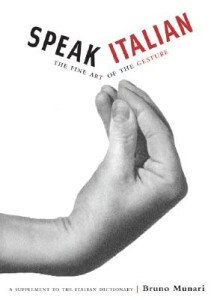Italy’s Love Affair With Hand Gestures
Posted on November 25th, 2013 by Anna in Uncategorized | No Comments »
Hand gestures and non-verbal language are a crucial part to any culture, and to the Italians more than most. In Italy, hand gestures are a natural way of illustrating a conversation, and typically the more immersed you get in what you’re saying, the more ebullient your gestures become. Growing up, I could see the stark difference between the Italian approach to gesturing as opposed to everyone else’s when we had our extended family over for Christmas dinner. Relatives on my father’s side, all of German-Irish stock, ate quickly and efficiently and cleared their end of the table to make way for dessert, drinks, and presents; three hours later, the Italian relatives on my mother’s side were still working away at their meals—they were busy talking, and of course talking involved the necessity of putting down utensils to move one’s hands along with the story.
The art of Italian hand gestures is both eloquent and subtle, and can require some translating to the uninitiated. For example, the way my nonna always urged me to come over to her was by extending her arm, palm-down, and flapping her fingers forwards and backwards—a gesture which can often be mistaken by English-speakers to mean “goodbye,” or “go away.” On the other hand, the iconic gesture of holding up one’s hands, palms inward, with all the fingers pinched together can have various meanings according to context, body language, and facial expressions: from “whaddaya want from me?” to “delectable!” to an expression of emphasis or urgency. A display of prayer hands, palms pressed together and fingers pointed Heavenward, generally accompanied with the exclamation, “Madonna!” connotes exasperation. To slice downwards with your thumb along your cheek expresses that you are impressed with someone’s cleverness, whereas pointing to the eye with the index finger from below implies that someone was sneaky or a smart-aleck.
So where did this culture of gesturing come from, and why did it catch on so famously in Italy? One theory is that, in light of a history of being almost constantly occupied by foreign nations, Italians came to depend on hand gestures as a secretive way of communicating under enemies’ noses. Another is that gesturing wildly was originally a method of gaining attention and standing one’s ground in overcrowded cities such as Rome and Naples. Interestingly, scholars have found gestures painted on Ancient Greek vases that correspond exactly to gestures still used in Italy, suggesting that while spoken languages evolve, gestures, which tap into something primal and instinctive, do not.
At any rate, hand gestures are so prevalent in Italian culture that, astoundingly, people will use them to punctuate telephone conversations. Some Italian gestures—particularly the insults—have even become universally recognized, such as the unmistakable using one arm to strike the inside of your elbow while the other arm shoots up, and the action of brushing your fingertips outwards along your chin. Actually, this second gesture, while interpreted as incredibly insulting in other cultures, is more a display of defiance among Italians, meaning something along the lines of, “I don’t give a damn.” In this light, hand gestures, whatever their origin, exist to preserve a sense of rebelliousness against authority figures, which Italy has had its share of throughout the ages. In a society that is becoming more and more impersonalized, gestures in any culture serve as an emphatic reminder of one’s individuality.






